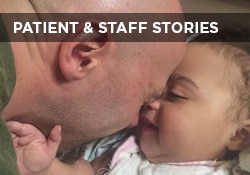This website uses cookies so that we can provide you with the best user experience possible. Cookie information is stored in your browser and performs functions such as recognising you when you return to our website and helping our team to understand which sections of the website you find most interesting and useful.

Susan E. Mazer, Ph.D. Blog
Thoughts and ideas on healthcare
Hi, and welcome to my blog! I'm Susan E. Mazer -- a knowledge expert and thought leader on how the environment of care impacts the patient experience. Topics I write about include safety, satisfaction, hospital noise, nursing, care at the bedside, and much more.
I Witness: My Under-the-Cover Patient Experience
July 12, 2013

Having just spent 10 days in the hospital with E. coli, enteritis, acute colitis, a urinary tract infection, and septicemia, I have great tales to tell about my patient experience.
Up until now, my only direct patient experiences besides routine check-ups have been outpatient surgery and a hysterectomy 20 years ago. At that time, all I noticed about the latter experience was that my uterus had been removed and I was admitted to a maternity room for an overnight stay.
Today, because I am deep into the implications of HCAHPS, patient’s rights, nursing advancement, and the patient experience, I pay more attention.
While researching and writing about HCAHPS, I have found the all too brief questions vague and subject to too much inference, particularly when it came to how a patient was treated by the other numerous hospital staff members. Neither the questions nor answers reveal why a patient feels disrespected, or what exactly causes even a single communication with a doctor or nurse to make a patient feel respected. Being treated with respect is decidedly different than being respected.
There are also no questions about CNAs, housekeepers, phlebotomists, lab technicians, ultrasound technicians, etc. Why are these healthcare professionals seemingly given a pass on being respectful and acknowledging or kind and compassionate?
As a patient, each person who walked into my room with a name badge was a touchpoint to recovery — however, most of the time, they were not interested in knowing who I was, what was happening to me, or what they might be able to do to help. Neither could they or would they, provide any new information even about how the hospital operated, leaving me frustrated and anxious. I am not talking about a CNA changing or administering medication. I am talking about the CNA as a patient advocate, even if just for a moment – being able to decide that a patient is in enough observable pain and discomfort to put down what she is doing and go get the nurse.
Perhaps the primary key to a real human connection is spontaneity — an authentic, engaged human response that is not scripted, contrived, or in want of anything. Our policy police have allowed HCAHPS and every other performance survey rob healthcare all of that.
What does remain are Rubik’s stations of productivity, where each person can ever only be one color, one cube, and can only move in a singular direction. Simple tasks that serve basic needs are frustrated, delivered as if they are not involving anything human, and everyone avoids the obvious: The patient is really sick and there is not much more “they” can do. And yet, each person touches the patient, the same patient, in ways that beg for more compassion, for more inventiveness, and more sensitivity, that begs for human connectedness.
An example of this is the difference between the aide that takes vitals once an hour (which may try to pass as rounds) and the aide that makes up the bed. So, the person comes in, takes my vital signs, and announces my blood pressure is 168/85…not even acknowledging that I told her my normal BP is 104/70. I was upset. I finally turned down the offer for a vital sign check. Seriously, refused. I also complained about my arms which were twice normal size, making the blood pressure band most painful. Nada. No response.
Then, the changing of the linen. No, not automatically done (Nightingale would have a fit!). In fact, I had to beg to have my soiled bed linens changed. If a pad could cover up the blood from a poor attempt to put in yet another IV, why change the sheet? If I was all tangled in the sheets and blankets trying to navigate two IV’s per arm, why bother trying to straighten all of this out? I hate unmade beds…and slept in one for 10 days…maybe three linen changes. On demand. Only if needed.
The housekeeper that removed the trash did not make eye contact long enough for me to thank her, and the nurse that collected a specimen paid more attention to the achievement of having a specimen than the person whose life seemed to be foretold in this vial of urine. Yes, different jobs. But, only one patient around whom is an army of people who talk to each other through laptops. It is this singular core experience that evaporates in a tornado of activity.
Now, in all fairness, I am describing this from the observation of being a patient, under the covers, in the bed, waiting to be helped to the commode, waiting for a med, waiting for ice chips — waiting for this whole episode to end. I am also far from uninformed. I am an astute observer of people, places, and processes. And, I am old enough to pay attention.
I also know that if my husband Dallas was not able to be with me every moment during my hospital stay, I may not have survived. And, I’m grateful that he was noticed and appreciated by the staff. However, it was only his loving disposition and patience that held us together. His way of dealing with lack of responsiveness was to “do it himself.” He knew where to find the hidden sheets and blankets, he just nosed around and found what we needed. I doubt anyone noticed…or cared.
Nonetheless, there are moments when the slightest act of kindness and inventiveness is pure magic.
I called for the nurse. The CNA, an older Philipino woman who was the sweetest of them all, walked in and asked what I needed. She knew I had been clock watching, that every hour was one closer to pain relief or nausea relief.
“Could you call my nurse,” I asked, “I need some Ativan,” This was a query based on my looking at the only medication that was PRN — on an as-needed basis.
This CNA had watched me suffer now for seven days. She had washed my back, changed my bedding, thanked my husband for his gentleness in helping her. To me, she seemed to be the only real person walking around.
She looked at me and quickly responded,: You don’t need an Ativan…you need a popsicle!” She then scurried out of the room to return only moments later with a red popsicle…totally within my limited diet, and fully pungent to my “ice-chips-only” palate.
It was the only fun moment of my entire hospital stay. Laughing, I was reminded that I didn’t want the Ativan; I wanted to be well again. And, it was the first time anyone had offered me a popsicle, although it was my fifth day on NPO (nothing by mouth) except for ice chips. There was no reason I couldn’t have one. It was totally delightful. And, I don’t even like popsicles.
The work of Healing Healthcare Systems has been, and remains, tending to patients during those hours when suffering is all that is going on. When the rest of the world has shut down but the fear and anxiety are just waking up. And, we do so by providing the C..A.R.E. Channel, which offers stunning nature and instrumental music. And it is not offered as a competitor to American Idol, Fox News, or ESPN.
While always available, C.A.R.E. Channel specifically comes into play when none of those programs can any longer please, distract, or relieve. And, in producing C.A.R.E., we think about the patient who does not lay in his or her bed with their glasses or contact lenses on, the patient for whom moving color is but a blur, and the patient who cannot tell whether it is day or night.
During the 10 days I was in the hospital, I was offered comfort through a single popsicle — and not until the seventh day of my stay. The flat-screen television in my room was so bright that I covered it with a sheet. The only instrumental music was a loop on the opening screen which, if I ever hear again, I am sure I will do something I will regret.
It was a new hospital building with lots of posters with smiling faces, and promises. I do not doubt the sincerity of these commitments; nor do I doubt that they are meaningful to everyone who walks in the facility. However, I now doubt the translation of all the pictures and words into a lived patient experience.
I further wonder whether the same caring promised to patients is offered to the staff. And, at this point, I question whether the best medical care in the world actually assumes responsibility for the unnecessary suffering of the moment, for the isolation of an illness, or for healing as well as curing.










